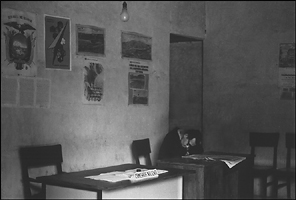
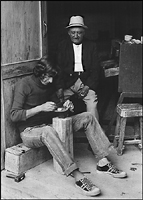
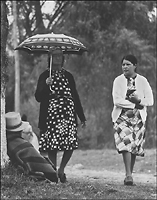
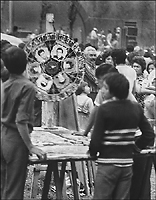
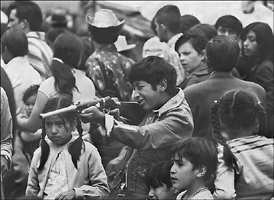
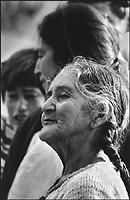
Home Ecuador
Most of the action during the festival took place down by the river, on the far side from town. A stage was located there, the back side of which was shaped like a conch shell, and was therefore referred to as “la concha”. It stood alone and unused most of the year in anticipation of these few days of activity. The trees along the river had been filled with strings of lights. A carnival had moved in among the trees and the thatched-roof shelters that were permanent fixtures along the river. A small ferris wheel carried happy passengers round and round through the air. Games of chance were among the most popular activities and most of these were based on some variation of the “wheel of fortune”. Temporary food stalls were erected where vendors sold corn, pork, chicken, soup, candied apples, popcorn, and barbecued beef-on-a-stick. Others offered sodas, beer, and Zhumir.
On Friday night, the reigning queen was presented to the crowd at the conch. Following the presentation there was a dance in town, not nearly so wild as the one during Carnival. Gone was the Zhumir, its place having been taken by a more prestigious scotch. Nothing had taken the place of the carioca, but once a year was enough of that. It was generally agreed that the band hadn’t been quite as good, but everyone had a good time, nonetheless.
Saturday morning was scheduled for the “Desfila Folklorico”, a parade around the town square and then down the road to the river, across the bridge, and to the bandstand. There was an army band, various local dignitaries, and groups of students representing some of the local schools. The students were dressed in costumes and performing dances and routines as they passed through the people lining the streets. One group of young girls had been outfitted as a band of butterflies, fluttering in unison over the cobblestones. Another group of young men and women were dancing in “black-face”, a curious reference to Negroes of whom there were very few in this part of Ecuador. Many strolling vendors were selling refreshments and souvenirs to the crowd. We all followed the “desfila” to the fairgrounds where we spent the day watching the musical entertainment on the stage, playing carnival games, eating, drinking, and lying in the sun.
While we were sitting in the shade of a large eucalyptus, a lady walked up with a bag in her arms and asked if we wanted to buy “animales”. We weren’t sure, and asked to have a look. Inside the bag were three creatures native to the Oriente, and which the lady referred to as “watusas” or “watusis”. She placed one of them on the ground in front of us. It was about the size of a large cat, but heavier built, with three toes on each foot, but lacking a tail. Its long, rather coarse fur was colored gray. It resembled a large, tailless rat, but the legs were longer, and it was very friendly. It licked our fingers. The lady said that they were “domesticados”. She claimed that they were fond of bananas and soup. The animal made a high-pitched squealing sound similar to that of a guinea pig. A crowd of people had gathered to gaze at the creatures. Many had heard the name of the animal, but few had ever seen one. However, there didn’t seem to be any potential customers in the group, so the lady returned the animal to the bag with its compatriots and walked off into the crowd.
After the sun had gone down, there was still a lot of activity down by the river. Two brass bands were standing on the rocks at the water’s edge and competing with one another to see who could blow the loudest and the liveliest. Riding the river’s current were hundreds of tiny lights, candles floating on the water. Into the air shot a cascade of sky rockets, bursting and showering their scintillating lights on the people by the river. Flowing with the water came a huge flower, its petals opening and closing. Within the flower stood the reina, waving and smiling at the multitude. The controlled motions of the flower were accomplished with the aid of six men wading in the river who manipulated the petals while pushing the float about. That was the climax of the evening’s entertainment.
As we were leaving, we were given a vivid example of a seeming contradiction in the Ecuadorian character. Most of the people we had met were kind and courteous in small groups or alone, but in larger groups, such as standing in a line for some sort of civic requirement, they could be what we would call rude. This applied somewhat more to the men than the women. After the reina’s cruise, we were attempting to cross the river over a pedestrian suspension bridge with rather narrow access openings on each end. The bridge, by the way, had been built to replace one which had collapsed into the river several years before, which made us even more uncomfortable during the mob scene that followed. There was a large number of people on the bridge, and much pushing and shoving and pulling. Midway across, the little bridge was being rocked and shaken violently by the crowd. We eventually made it across, but it left a reservation in our minds in our regard for our Ecuadorian friends. Whenever there was a situation in which a number of people wanted the same thing at the same time, there’s no semblance or order and a great lack of courtesy, with plenty of shoving, and liberal use of elbows. But then, maybe this is more a feature of the human race than the Ecuadorian character.
The festival lasted several days more, but our time in Ecuador was growing short, and we still hadn’t been to what was, in our minds, one of the most exciting and alluring parts of the country. Two days later we began our journey to the Oriente.